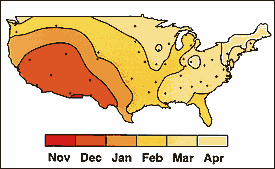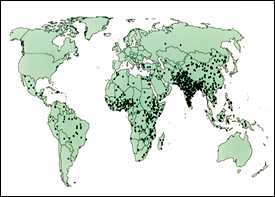Rotavirus Epidemiology
Rotavirus is a common childhood diarrheal illness, with 95% of children
ages 3-5 having already contracted the virus. It is also the most severe.
It causes 1/3 of diarrhea associated deaths and kills more than 873,000
children worldwide. 2.7 million children age 5 and younger are affected
each year in the United States alone, causing 150 deaths, 500,000 doctor
visits, 50,000 hospitalizations, and $274 million in medical care and $1
billion in societal costs. The huge numbers of infected individuals stem
from the fact that 10 10 particles per gram of feces are shed
for 3-7 days
in normal individuals. The length of time is even greater in
immunocompromised individuals. Rotavirus is highly infectious and a dose
of less than 100 particles is enough to lead to infection and cause
disease. 95% of Rotavirus isolates are from serotypes 1, 2, 3 and 4.
The virus is spread mainly by contact with feces and while it can be
decreased by increased hygiene, this technique has proved virtually
impossible in young children. It may also be spread through respiratory
secretions, person to person contact, or contaminated environmental
surfaces, such as diaper pails and toys, as there are high rates of
infection even in the most sanitary conditions. Noscomial infections are
quite common as well as waterborne epidemics, as Rotaviruses are resistant
to chlorination. They have an incubation period of less than 48 hours.
The virus tends to peak in winter and fall in temperate climates. In the
US, Rotavirus activity starts in the Southwest in autumn and moves to the
Northeast by Spring. In the tropics the virus tend to be endemic
year-round.
 Rotavirus activity by season in the United States July
1991-June 1997.
Reprinted from
Emerging Infectious Diseases Volume 4 Number 4 Oct-Dec
1998.
Rotavirus activity by season in the United States July
1991-June 1997.
Reprinted from
Emerging Infectious Diseases Volume 4 Number 4 Oct-Dec
1998.
Rotaviruses have been found all over the world. Developing countries are
particularly hard hit by Rotavirus, with an average of 2000 children dying
each day from Rotavirus infection. Nutrition seems to play a large role
in the mortality rates of this virus, as those children already in
distress face much more severe symptoms when infected. Death by Rotavirus
may be prevented by either Oral Rehydration therapy which replaces lost
electrolytes in the child or by a vaccine that has just recently (Aug.
1998) been approved by the FDA.
 Global Distribution of deaths caused by Rotavirus.
Reprinted from
Emerging Infectious Diseases Volume 4 Number 4 Oct-Dec
1998.
Global Distribution of deaths caused by Rotavirus.
Reprinted from
Emerging Infectious Diseases Volume 4 Number 4 Oct-Dec
1998.
Back


